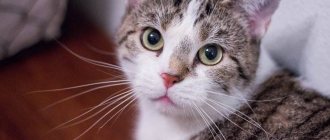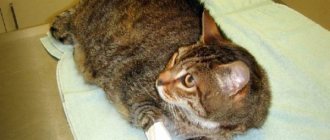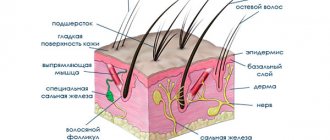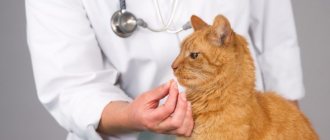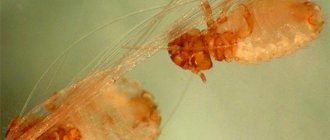Coughing is a protective reaction of the cat’s body from foreign objects that enter the respiratory tract, esophagus or stomach. Coughing can also be caused by hairballs in the stomach, inflammatory processes in the respiratory system, attacks of allergies or bronchial asthma.
If the owner notices that the cat is choking and coughing, as if it has choked, immediate measures must be taken to save the animal from suffocation. Let's find out why a cough occurs and how to independently help your pet before the veterinarian arrives.
Mechanism of cough development
A periodically occurring cough in a cat may indicate the development of inflammatory processes in the respiratory system, which require long-term treatment under the supervision of a veterinarian. It can also occur when trying to get rid of hairballs that accumulate in the animal’s stomach.
However, if the cat spontaneously begins to cough, wheeze, stretch out and press itself to the floor, this most often indicates ingestion or inhalation of small foreign objects. In this case, the animal must be quickly assisted or taken to the clinic without delay.
A cough is a strong, accelerated exhalation through the mouth, which occurs due to a sharp contraction of the muscles of the respiratory tract as a result of irritation of the receptors. In this way, the cat's respiratory tract is freed from mechanical substances that impede the movement of air along the airways.
The cough algorithm consists of the following stages:
- take a deep breath for no more than 2 seconds;
- reflex contraction of the smooth muscles of the larynx, which closes the glottis;
- increased tone of the bronchial muscles;
- sharp contraction of the abdominal muscles;
- opening of the glottis;
- a powerful exhalation that expels foreign agents.
How to treat
After determining the provoking factors, appropriate treatment is prescribed. Using medications without consultation with a specialist can cause negative consequences. The wrong choice of medication or its dosage can lead to complications. However, it is very useful to familiarize yourself with general information about existing drugs. In some cases, you can use tablets intended for humans. It is not recommended to give syrups due to the large amount of sugar, dyes, and flavors they contain. Medicines containing codeine and alcohol are also not allowed.
Blocking substances help to quickly eliminate attacks, but do not affect its source. Therefore, they can be given to your pet only in combination with other means. Expectorants do an excellent job of treating infectious coughs by thinning mucus and removing it from the respiratory tract.
How to treat a cough
Types and symptoms of cough in cats
The classification of cough in cats is described in detail in the table.
| Characteristics of cough | Degrees and types of cough manifestations |
| Force | slight cough; hacking cough |
| Form depending on duration | acute (less than 14 days); prolonged (from 14 to 45 days); chronic |
| Timbre | silent; voiced; deaf; hoarse; hoarse; barking |
| Presence of discharge | dry; wet |
| Character of sputum | serous; slimy; purulent; mixed with blood |
| Development time | constant; seasonal |
Symptoms that most often accompany coughing in cats include:
- discharge from the nasal cavity;
- vomit;
- wheezing.
The nature of the cough helps specialists make the correct diagnosis, identify the causes and prescribe appropriate treatment for a coughing cat.
Treatment
The goal of any treatment procedure to combat cough is to eliminate the cause that caused it:
- For helminthic infestations, drugs that destroy worms are prescribed. Prevention – regular deworming.
- If cardiac pathologies are detected, the functioning of the heart and vascular system is stabilized. The cat is put on a special diet.
- To treat respiratory infections, antiviral agents and antibiotics are prescribed, depending on the specific disease.
- There is no way to completely cure asthma. Lifelong therapy is indicated for the animal. Corticosteroids are recommended to relieve swelling and inflammation, and bronchodilators are recommended to ease breathing.
- If the cause of cough spasms is trichobezoars, special pastes or a diet are prescribed that facilitate the removal of hair from the stomach naturally.
- When the injuries and scratches from the bones heal, the soreness and cough go away. Therefore, only nutritional recommendations are given. During the recovery period, the animal is switched to soft food.
Main causes of cough in cats
Veterinary experts identify 6 main causes of cough in cats.
- Bronchial asthma. This is one of the types of allergies that occur in a cat to foreign components that can be contained in dust, pollen, hair from other pets, dead particles of human skin, as well as in medications and chemicals.
- The presence of foreign objects in the upper respiratory tract, esophagus or stomach.
- Pathologies of the cardiovascular system.
- Helminthic infestations. During migration, Toxocara larvae enter the lungs. This most often occurs in young animals due to untimely deworming after weaning. In this case, the kitten coughs heavily and may vomit a foamy mass in which parasites are found. The cat may also cough constantly due to the presence of heartworms in the pulmonary arteries. These thin, long helminths parasitize the heart, pulmonary artery and small capillaries. They clog blood vessels, which causes frequent severe coughing, vomiting, shortness of breath, loss of appetite, and in case of severe infestation, convulsions and death.
- Infectious diseases of the upper respiratory tract. The most common diseases include herpes, rhinotracheitis and calicivirus.
- Pneumonia. The etiological factors for the occurrence of pneumonia in cats are pathogenic bacteria, viruses, microscopic fungi, as well as external factors such as hypothermia, eating cold food, and keeping the animal in unsanitary conditions.
- Malignant tumors in the respiratory organs.
Important! Among infectious agents, a special place is occupied by the pathogenic bacterium Bordetella bronchiseptica, which causes bordetellosis. Most often, this disease is transmitted by airborne droplets when cats are kept in crowded conditions in nurseries. The infection is also spread by stray cats, which can infect free-roaming pets.
If the cat is coughing heavily and breathing heavily, then the cause of this condition may be pneumo- or hydrothorax, caused by the penetration of air or liquid into the chest cavity.
Helminths
Worms that appear in the body irritate the mucous membrane, causing a cough. This is often accompanied by weight loss, vomiting and dandruff. To combat them, the pet is given antihelminthic medications. In severe cases, they are given again a week after the first dose. Delay can lead to problems with the liver, kidneys and even death.
Trichobezoars, coughing up hair
Cats groom themselves by licking their fur coat with their tongue. That, in turn, can enter the digestive organs. The lumps formed there provoke coughing. It doesn't pose a threat. A paste that dissolves lumps or special food will help.
To measure the temperature
Throat injuries
They also irritate the larynx. Sores and ulcers can be a sign of chlamydia, which people can become infected with.
Heart diseases
Cardiac cough gradually intensifies and is accompanied by lethargy, shortness of breath, and heavy breathing. A cardiogram will confirm this version.
Respiratory diseases
These include viral, bacterial, and fungal infections. Immediately the cough is dry and loud. On the second day, sputum separates and he becomes deaf. In addition, nasal discharge, rotting of the eyes, weakness, and increased body temperature appear.
Diagnosis of the condition
The multiplicity of causes that can cause cat cough makes it very difficult to diagnose cats. Therefore, the veterinary specialist consistently conducts a series of studies, including:
- collection of anamnestic data;
- inspection;
- palpation;
- percussion;
- auscultation;
- general and clinical blood test;
- radiography;
- coprogram for identifying intestinal helminth eggs.
If it is not immediately possible to determine the reason why the cat cannot cough, the veterinarian will prescribe additional laboratory and instrumental tests.
Note! Only large veterinary clinics can afford additional research, and the cost of these services is quite high. Therefore, it is advisable to carry them out more often for such high-pedigreed “expensive” cats as Sphynx, Maine Coon, Peterbald, Scottish Fold and others.
Specific additional studies that will help determine exactly why a cat is coughing with wheezing include:
- sputum analysis for the presence of viral agents and their identification;
- fluoroscopy of the esophagus using a contrast indicator;
- endoscopy of the upper respiratory tract and esophagus;
- bronchoalveolar lavage (performed under general anesthesia).
If the doctor suspects that the cat cannot cough due to the development of pathology of the cardiovascular system, the doctor will prescribe an ECG or ultrasound of the heart.
Heart problems
Many people do not know what to do if a cat coughs and wheezes, for what reason this reflex occurs. A serious reason to see a doctor is the occurrence of heart problems. Most often, this disease occurs in old and overweight animals. At first, coughing rarely bothers the animal, but later it inevitably becomes more frequent.
The disease is diagnosed by tactile and visual examination. The pet's blood pressure is measured, electrocardiography and radiography are performed. Such a disease requires lifelong care for the animal and maintenance therapy. Treatment is prescribed by a veterinarian based on the research results obtained. Giving medications at your own discretion is strictly prohibited.
The cat must be provided with rest, proper nutrition and follow the doctor's instructions. For animals with this pathology, special dietary foods are sold in pharmacies.
How to treat cat cough
If a cat is coughing, it can be treated at home only after being examined at a veterinary clinic, making an accurate diagnosis and prescribing appropriate therapy.
You should not self-administer cough suppressants before visiting a doctor, as this may change the clinical picture of the disease and make it difficult to determine the cause of the pathology.
Important! If the cat is coughing and wheezing, as if he is choking, then you should not take any independent action. It is better to quickly take your pet to the hospital or call a doctor at home. Delay can also be fatal when the cat wheezes, trying to burp, but only spits up saliva or foamy liquid.
If a cat coughs due to an infectious disease of viral etiology, the doctor prescribes:
- antibacterial drugs (Amoxisan, Sinulox, Tsiprovet) to prevent the development of secondary bacterial infections;
- mucolytic and expectorants (Bromhexine, licorice extract);
- immunomodulators (Cycloferon, Fosprenil, Maxidin);
- globulin Vitafel;
- intravenous injections of Ringer-Locke solution or saline with 5% glucose (to prevent dehydration when refusing food).
If the cough is accompanied by wheezing and the cat coughs while stretching its neck, then the cause may be pneumonia or another inflammatory process in the respiratory system. In this case, antibiotics are first prescribed. And to relieve coughing, the cat should be given antispasmodics, mucolytics and expectorants.
If a cat's cough is accompanied by vomiting, this often indicates helminthiasis. In this case, anthelmintic drugs are prescribed (Pyrantel, Prazicide, Drontal, Milbemax). Despite the fact that these medications are sold in pharmacies without a prescription, you should not use them yourself if your cat wheezes and tries to burp.
In case of severe infestation, an incorrectly selected dosage can lead to excessive activity of parasites and lead to suffocation. Illiterate actions by owners can also lead to intestinal rupture or excessive intoxication in small kittens.
If the reason that the cat is coughing and stretching its neck, as if choking, is trichobezoars, then the doctor will prescribe special pastes and gels to remove or dissolve hairballs in the stomach.
If a cat coughs and wheezes with its tongue hanging out, this may indicate an attack of bronchial asthma. You can quickly relieve an attack with:
- glucocorticosteroids (Hydrocortisone, Prednisolone, Dexamethasone, Fluocinolone);
- bronchodilators (Theophylline, Atropine);
- antibiotics (if there is a threat of infection by pathogenic bacteria).
Important! Self-administration of glucocorticosteroid and bronchodilator drugs to treat Sphynxes and other cats when they cough while stretching their necks can lead to overdose, complications and the development of side effects. Therefore, you should not put your pet’s life at risk; you must urgently take him to the clinic.
The reason that the cat is coughing, wheezing, as if he is choking, may be a heart attack, which develops in the cat as a result of a hidden pathology of the cardiovascular system. In this case, any independent treatment is unacceptable.
You should immediately call the clinic, call a veterinary specialist to your home and get a recommendation on the actions that need to be taken before his arrival.
What you need to pay attention to when treating a cough
I remind you once again that a cough is a symptom of a disease, therefore, on the one hand, in order to reduce its intensity, it is necessary first of all to understand the causes of its occurrence. On the other hand, being a protective reaction of the body, a cough can be beneficial and speed up recovery. In other words, in many cases it is not worth fighting a cough to the bitter end with the help of antitussives. Along with recovery from the underlying disease, the cough will also stop.
The exception is a dry, painful cough, which causes severe anxiety in the cat and even attacks of suffocation. In this case, the cough loses its protective nature and requires immediate attention to a veterinarian.
Nature, “creating” the immune system in cats (and other predators), emphasized antibacterial immunity. This is due to the fact that when hunting and fighting for territory, the wild ancestors of our pets very often received infected injuries and wounds. And without good immune protection against bacteria, it is impossible to survive in the wild. But in the “fight” against viruses, cats are still very far from winning. Therefore, bacterial infections of the nasopharynx (and with them the so-called respiratory cough) are much less common in cats than in humans, and develop only against the background of a severe weakening of the immune system (which, as a rule, leads to various viral infections). In this regard, such a concept as a “cold” is not suitable for cats.
How to understand that a cat is not just coughing, but choking
If a cat coughs, wheezes and at the same time stretches out, pressing her whole body to the floor, then in 99% of cases this indicates that a foreign object has entered the esophagus or respiratory tract. When a cat coughs as if he is choking, you should not do anything on your own. You should immediately take your pet to the clinic.
Sometimes the cat gags and coughs, as if he wants to vomit, but attempts remain to no avail. This may indicate that the pet is unable to get rid of a large trichobezoar in the stomach on its own.
If the cat coughed, as if she was choking, but quickly came to her senses, then there is no reason to worry, as she could simply have choked.
Cough with heart disease: what kind and who is more likely to have it?
The enormous problem is that the pathological condition that could provoke cardiac diseases develops gradually. The latent form lasts from 6 to 8 months.
Cough due to heart problems develops most often in giant dogs and large breeds over 7 kg. This is explained by the anatomical features of the structure, the discrepancy between body size, muscle mass and the volume of the heart itself. Oddly enough, in large dogs and giants the heart muscle is small, and from a certain point it ceases to cope with its functions, unable to bear high loads, which becomes the cause of cardiac problems.
How to help a cat who is choking
If, after eating fish or tubular bones, the cat sticks out its tongue, coughs, wheezes, or simply sits with its mouth slightly open, then there is a high probability that a sharp bone is stuck in its throat or esophagus.
If you have experience with animals, you can try to remove it yourself. But this can only be done if the bone is clearly visible in the oral cavity. To do this, you need to secure the cat. Then ask an assistant to hold the animal and try to open the pet's mouth wide.
The next step is to remove the bone using tweezers.
If the cat coughs, wheezes, or sticks out its tongue and makes wheezing sounds, but upon examination a foreign object cannot be detected, then the animal should be taken to the doctor immediately.
Main symptoms
It is very easy to identify a cough in your pet. The cat unnaturally stretches its neck forward, tilts its head, and opens its mouth. He coughs with his mouth open, making characteristic sounds. From the outside it may seem that your four-legged pet is vomiting. Most often, vomit is released along with the cough.
If the cough is isolated, then this should not be a cause for concern. With the help of a reflex, the animal simply tries to relieve irritation on its own. It’s another matter if the cough is prolonged, accompanied by other signs, such as snoring and wheezing.
It should be noted that a cat may snore from time to time, for example, when there is a lack of water. She may sometimes experience wheezing - when the animal swallows too large a portion of food.
However, if the above symptoms are presented together and are accompanied by changes in behavior (refusal to eat, restlessness, decreased activity, weight loss, exhaustion, etc.), this is already a reason to visit a veterinary hospital.
